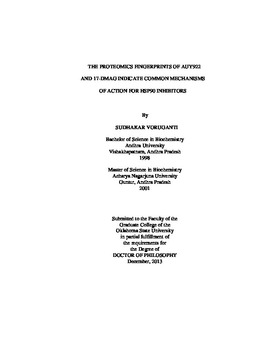| dc.contributor.advisor | Hartson, Steven D. | |
| dc.contributor.author | Voruganti, Sudhakar | |
| dc.date.accessioned | 2015-06-17T20:08:21Z | |
| dc.date.available | 2015-06-17T20:08:21Z | |
| dc.date.issued | 2013-12 | |
| dc.identifier.uri | https://hdl.handle.net/11244/15159 | |
| dc.description.abstract | In this work, we identified the proteomics fingerprint of the anti-cancer drug candidate AUY922 in Jurkat leukemia cells and compared AUY922's fingerprint to the proteomics fingerprints of flagship Hsp90 inhibitors 17-DMAG and radicicol. Protein expression changes were identified by a label-free mass spectrometry technique, spectrum counting using a bottom-up proteomics approach. We identified 30 protein expression changes that were conserved among all the three Hsp90 inhibitors. To further validate findings from spectrum counting assays and to identify more Hsp0 inhibitor induced protein expression changes, we quantified AUY922-induced and 17-DMAGinduced protein expression changes by label-based Stable Isotope Labeling with Amino acids in Cell culture (SILAC) using a bottom-up proteomics approach. A total of 3000- 4000 inhibitor-induced protein expression changes were quantified. After statistical validation, 260 protein expression changes were found to be conserved among both the Hsp90 inhibitors. The large conservation of protein expression changes between AUY922 and 17-DMAG suggested that both inhibitors work via a similar mechanism. The protein expression changes common to AUY922 and 17-DMAG identified in this study can be used as biomarkers to test bioactivity of AUY922 in clinical trials and can also be used to validate new Hsp90 N-terminal inhibitors. Additionally, they can be compared to the proteomic fingerprints of agents that bind to the C-terminal domain of Hsp90, to determine if both classes of inhibitors share similar mechanisms of action. I also demonstrated that the anti-proliferative effects of AUY922 could be enhanced in combinatorial treatments with protein folding antagonist L-azetadine-2-carboxylic acid (AZC). I further used the SILAC approach to determine the mechanism of combinatorial effects of AUY922 and AZC and showed that the combinatorial effects were largely due to AZC-mediated suppression of chaperone induction. Thus, findings from this study suggest approaches for enhancing AUY922's activity in clinical trials by using AUY922 in combination with agents that suppress chaperone induction. | |
| dc.format | application/pdf | |
| dc.format | application/vnd.ms-excel | |
| dc.language | en_US | |
| dc.rights | Copyright is held by the author who has granted the Oklahoma State University Library the non-exclusive right to share this material in its institutional repository. Contact Digital Library Services at lib-dls@okstate.edu or 405-744-9161 for the permission policy on the use, reproduction or distribution of this material. | |
| dc.title | Proteomics fingerprints of AUY922 and 17-DMAG indicate common mechanisms of action for Hsp90 inhibitors | |
| dc.contributor.committeeMember | Matts, Robert L. | |
| dc.contributor.committeeMember | Melcher, Ulrich | |
| dc.contributor.committeeMember | Deng, Junpeng | |
| dc.contributor.committeeMember | Burnap, Robert | |
| osu.filename | VORUGANTI_okstate_0664D_13033.pdf | |
| osu.accesstype | Open Access | |
| dc.type.genre | Dissertation | |
| dc.type.genre | Numeric Data | |
| dc.type.material | Text | |
| dc.type.material | Dataset | |
| dc.subject.keywords | 17-dmag | |
| dc.subject.keywords | auy922 | |
| dc.subject.keywords | hsp90 inhibitors | |
| dc.subject.keywords | jurkat | |
| dc.subject.keywords | proteomics | |
| dc.subject.keywords | silac | |
| thesis.degree.discipline | Biochemistry and Molecular Biology | |
| thesis.degree.grantor | Oklahoma State University | |
